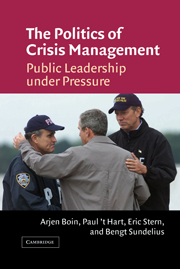Book contents
- Frontmatter
- Contents
- List of figures and table
- Acknowledgments
- 1 Crisis management in political systems: five leadership challenges
- 2 Sense making: grasping crises as they unfold
- 3 Decision making: critical choices and their implementation
- 4 Meaning making: crisis management as political communication
- 5 End games: crisis termination and accountability
- 6 Learning from crises and the politics of reform
- 7 How to deal with crisis: lessons for prudent leadership
- References
- Index
3 - Decision making: critical choices and their implementation
Published online by Cambridge University Press: 22 September 2009
- Frontmatter
- Contents
- List of figures and table
- Acknowledgments
- 1 Crisis management in political systems: five leadership challenges
- 2 Sense making: grasping crises as they unfold
- 3 Decision making: critical choices and their implementation
- 4 Meaning making: crisis management as political communication
- 5 End games: crisis termination and accountability
- 6 Learning from crises and the politics of reform
- 7 How to deal with crisis: lessons for prudent leadership
- References
- Index
Summary
The myth of chief executive choice
On July 14, 1958, US President Eisenhower woke up to the news of a coup in Iraq, overthrowing one of the few pro-Western leaders in the Middle East. In the light of the increasing Soviet dominance and the recent merger between Syria and Egypt into the United Arab Republic, with the strident Nasser as its president, the Iraqi coup meant a blow to the United States' position in the Middle East. The sense of crisis in Washington, DC was heightened when the Lebanese president called for immediate US intervention, fearing that his country would be next. It was 9 am. After consulting with his advisers and his political counterparts on the Hill, President Eisenhower announced the decision to send in the Sixth Fleet at 2.30 pm.
This long-forgotten example of presidential crisis decision making illustrates a classic notion of crisis leadership: making the critical call when it matters most. Both successes and failures of crisis management are often related to such monumental decisions. This notion of crisis as “occasions for decision making” is a dominant one in the scholarly literature on crisis management. The image of the command room, the tragic dilemma, and the decisive leader not only informs academics and Hollywood movies but also plays to a widespread expectation in times of crisis: leaders must govern.
Many studies of crisis management report an “upward” shift in decision making: the scale of response is adjusted to the scale of the impact.
- Type
- Chapter
- Information
- The Politics of Crisis ManagementPublic Leadership Under Pressure, pp. 42 - 68Publisher: Cambridge University PressPrint publication year: 2005



